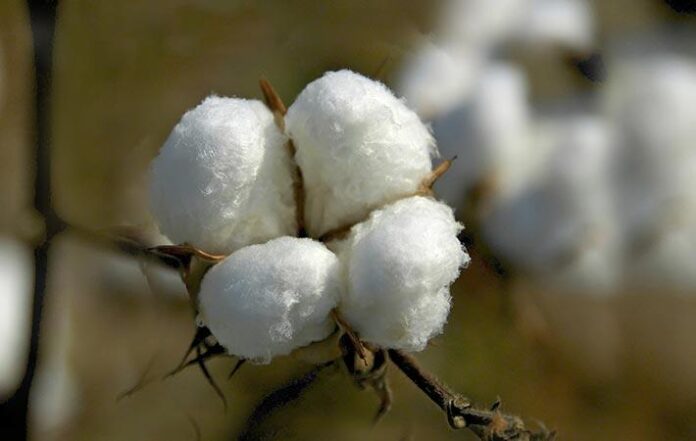ISLAMABAD: The chest thumping was audible on Tuesday when Pakistan’s interim Commerce Minister Gohar Ejaz proudly announced that cotton arrivals in Pakistan had already crossed 5 million bales this year with an entire quarter left in the year.
While the thumping may have been slightly muted by the commerce minister proudly posting a picture of a field of white flowers mistaking it for cotton (made worse by the fact that before his latest tryst as a government minister Mr Ejaz was Chairman of the All Pakistan Textile Mills Association whose business is based entirely on cotton) there is much to be taken away from this year’s cotton output.
According to data provided by the commerce ministry, 5 million bales of cotton have already been delivered to ginning factories with three months to go in the season.
Last year, Pakistan saw its lowest ever output for cotton when the country produced only 4.8 million bales of cotton. As a result, the export-oriented textile industry had to import cotton from the United States to meet the shortfall which was difficult because imports were restricted in the country. This led to textile factories shuttering their doors for long periods of time. So how have things turned around so quickly this year? Essentially because of a trick of the international cotton market.
Some context
Pakistan’s cotton has been suffering for the past few decades. From the early 1980s up until around 2008 white lint was one of the most popular crops in the entire country. According to a 2021 report of the International Food Policy Research Institute (IFPRI), raw cotton consumption grew at an annual growth rate of 7% between 1982 and 2008. In fact, 2008 was witness to the biggest cotton crop in Pakistan’s history at 15.6 million bales. It was a pretty neat system. Textile mills needed lots of cotton to produce clothes and export them and farmers knew that if they grew cotton they would have definite buyers. All in all it was an ideal situation.
Until it wasn’t.
Between 2007-8 Pakistan was hit by the global recession. The textile industry faced challenges due to high energy costs, rupee depreciation vis-à-vis the US $ and other currencies, and a high cost of doing business. As a result, there was a reduction in the number of textile mills operating in the country from about 450 units in 2009 to 400 units in 2019. This decrease has simultaneously seen the domestic demand for cotton dip in the country. In this time cotton has fallen out of demand, become internationally uncompetitive, and output has fallen by a whopping 65% from 14 million bales being produced in 2005 to 4.9 million bales being produced in 2023.
So what happened this year?
The expectations this year were high. Cotton generally has fallen out of favour but weather patterns this year it seemed the weather would permit a higher yield. On top of this August proved fateful. As the Kharif season was starting, the Trading Corporation of Pakistan (TCP) entered the cotton market to stabilise the white lint prices. TCP announced it would purchase one million bales of lint to stabilise the market so that the growers may get the minimum rate of Rs8,500 per maund as promised by the government at the outset of the sowing season to woo the farmers back to the crop.
But why was the government suddenly so interested in cotton? Essentially, the United States was hit with a low production year. Cotton production in the US in 2022-23 is forecast to fall by 3.7 million bales from the previous marketing year (MY) to 13.8 million bales, the lowest production level in seven years. This will result in US cotton exports for MY 2022-23 to fall at 12.5 million bales, down by 100,000 bales from the previous month’s forecast and 14 per cent lower than MY 2021-22, according to the US department of agriculture (USDA).
US Cotton was facing the same issues as Pakistan — high temperatures and drought in Texas, where 40 percent of US cotton production occurs, have slashed production and exportable supplies. As a result global trade is down by nearly a million bales from the previous month’s forecast.
The perfect storm
It is a case of things falling exactly in place. On the one hand US expected output fell significantly. Overall cotton prices improved in the domestic market as textile millers and spinners showed their interest in buying during the last week, while the quality of lint reaching ginning factories also got relatively better due to the end of rains in the cotton belt resulting in reduced moisture in phutti (raw cotton). The buying interest was reinforced by reports that the TCP had prepared a strategy to purchase one million bales and had appointed agents in various cotton districts for the purpose.
There was a brief moment of worry when the cotton crop in Punjab faced an onslaught from whiteflies, which proved to be a nightmare for growers and agriculture department high-ups giving them sleepless nights. However, the government of Punjab to their credit swooped in with efficiency and used helicopters As of September 30, 2023, the nation witnessed an astounding achievement with cotton arrivals surpassing the 5 million bales mark, reflecting an impressive year-on-year growth rate of 71%.
As per data shared by the Ministry of Commerce, the sector, which faced a devastating 34% year-on-year decline in production due to the catastrophic flooding, has not only managed to recover but has exceeded all projections for this year.
Key yield figures show that:
– Pakistan: 5.0 million bales, marking a remarkable 71% year-on-year increase.
– Punjab: 2.1 million bales, showcasing a commendable 34% year-on-year growth.
– Sindh: 3.0 million bales, achieving an astonishing 113% year-on-year surge.
Dr. Gohar Ejaz, the Minister for Commerce, expressed his optimism for the cotton sector’s future, stating, “Cotton arrivals crossing the 5 million bales mark on October 1, 2023, is a momentous achievement for Pakistan. Last year, our total crop was 5 million bales, and this year, we are anticipating a bumper crop of 12 million bales. This remarkable growth showcases the dedication and hard work of our farmers and the resilience of our cotton industry. The Ministry of Commerce remains committed to supporting and promoting the cotton sector in Pakistan, recognizing its indispensable role in the country’s economic development and global competitiveness.”
Why this may be an anomaly
This year’s good fortune does not solve the larger issue. Years when things fall in place will come and go. A similarly good year had also come back in 2021-22. Back then the cotton crop that was sown in Pakistan in 2021 and was harvested in 2022 benefited from a peculiarity of international trade caused by Covid-19 that resulted in a bumper crop of cotton.
When the pandemic hit, everything changed and the local industry found that importing cotton was no longer an option. International cotton prices (in rupee terms) during the last year have gone up by almost 30% — from PKR 12,606 on July 1, 2021, to PKR 18,259 by mid-February this year. The ever-dwindling value of the rupee not only doubled the impact of import for Pakistani millers but also made it next to impossible to calculate the final cost of production, rendering import commercially non-feasible for the industry.
Similarly this year it was the falling fortunes of US cotton that helped Pakistan’s cotton growers. The reality is that cotton has overall seen a serious decline in the country. The story of cotton in Pakistan has been that of an opportunity squandered. Between 2005 and 2020, Pakistan’s production of cotton declined by nearly 35%, from nearly 14 million bales in 2005 to just over 9 million bales in 2020.It further fell to 5.6 million bales in 2021, before making a brief recovery at 7.7 million bales in 2022, and has now fallen to a paltry 4.9 million bales in 2023. This marks an overall decline of 65% in the past 18 years.
The data speaks for itself. Zoom in to cotton production over the past few years and it is a sordid tale. As recently as 2017, Pakistan’s cotton production was high, clocking in at over 10 million bales for the year. The output actually rose by a million bales to 11 million in 2018, before settling again at just over 9 million bales in 2019. The next two years saw a decline. In 2020, only 8 million bales were recorded before a sharp fall to 5.6 million bales in 2021.
As the core issues of the cotton crop remain unaddressed, farmers will continue to abandon this crop and instead grow richer products such as sugarcane which are short term cash crops but bad for agriculture and the climate in the long-run.
























Here are the two prevalent reasons for poor cotton farming in Pakistan.
1. Last year’s cotton crop in south Punjab destroyed because of the rainfall. Cotton seeds inside the cotton bulb started to grow into seedlings while it was still unpicked. We couldn’t produce anything.
2. Sugarcane is replacing cotton because of the price & pests. Consective farming of sugarcane and lack of crop rotation is destroying agri-land in long-run.
Cotton crop is big support for Pakistan economy to boost
When there is nothing substantial for ‘chest thumping’ and to be proud of, you stoop to such low trivialities and try to seek credit for everything. The government has no role in the so-called bumper crop of cotton. They should be thankful to Allah for this blessing and think ahead. The past ten months since January 2023 have been the most depressing and various developments in the country have contributed to this gloomy situation. PDM and the interim setup are together responsible for this all.
cotton rate is 9000 rupees we wanted